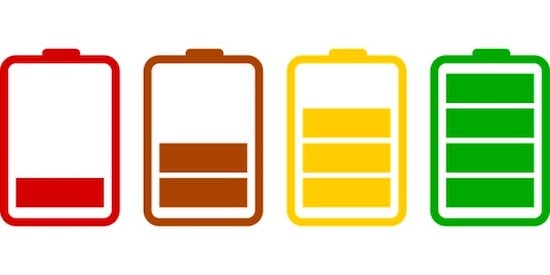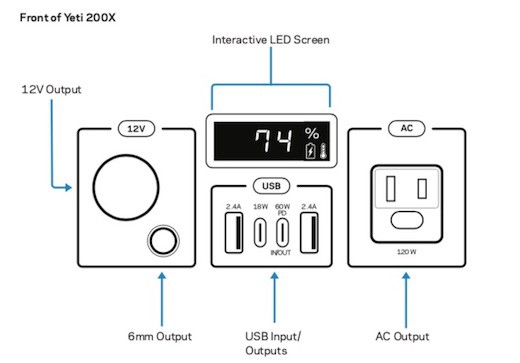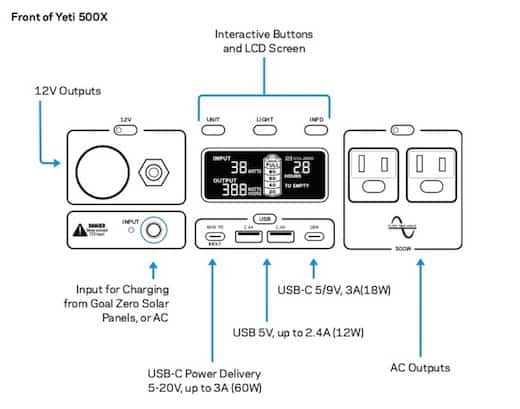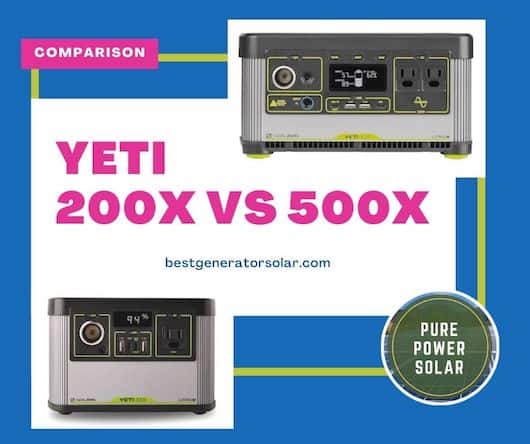Among the top players in the solar energy industry is Goal Zero.
Robert Workman founded Goal Zero in 2007 in the Democratic Republic of the Congo in Africa.
Thus, the production of solar energy appliances commenced in 2008, and ever since, Goal Zero has continued to churn out quality solar energy appliances.
As of the beginning of 2020, the company has numerous solar energy appliances, including solar panels, portable solar power stations, solar power banks, bulbs, and more.
Of these numerous appliances, there are two solar generators in Goal Zero’s “X” series that are significantly more compact than the other four solar generators in the lineup.
These generators are the Goal Zero Yeti 200X and Goal Zero Yeti 500X.
Both of these power stations are top-quality and have many beneficial features. As a result, it becomes a bit difficult to choose the better of the two solar generators.
This article comes to your rescue if you are in such a dilemma. It reviews the two solar generators, discussing their features, specifications, benefits, and possible downsides.
You will also get an unbiased review of these power stations’ performance, helping you choose between the two generators.
The Goal Zero Yeti 500X is the better of the two solar generators. Although the 500X is heavier than the 200X, its output, battery capacity, and inverter size significantly outperform that of the Yeti 200X, making it the better option.
An Overview of the Goal Zero Yeti 200X
One of the first things you notice when you review the Yeti 200X is its weight.
According to Goal Zero, the Yeti 200X is its lightest power station. And rightly so, as it weighs just five pounds.

This is a major win for the power station, especially for those who want to go camping and exploring life outdoors.
The battery capacity is 187Wh.
While you won’t be able to power medium and heavy-duty appliances with this power station, the Yeti 200X will keep most of your small gadgets and appliances powered for a significant period of time.
Another impressive feature is its charging options. The Yeti 200X provides three different charging options in its framework.
You can charge the power station using an AC wall socket, solar panels, and a car charger. All of these options have a particular duration, so you can choose the options that best fit you.
For instance, you could charge the solar generator with your car when you are on a long road trip and do not need fast charging. Should you be in need of fast charging, the AC wall socket is your best bet.
Lastly, you get multiple outlets on the solar generator, allowing you to power multiple devices and gadgets at once.
Yeti 500X Product Overview
The Yeti 500X is the next product in line after the Yeti 200X.
The solar generator features a battery capacity of 505Wh. This means that the power station has enough juice to go around when it comes to small and medium-sized gadgets and devices.
Thus, if you are thinking of going for a camping trip or RV outing, the Yeti 500X is a worthy companion for your devices.
Apart from the battery capacity, another exciting feature of the Goal Zero Yeti 500X is its body design. Goal Zero has a reputation for beautifully crafted products, and this power station has lived up to the hype.
It features a solid and rugged design that can receive some rough handling without damaging the power station’s core components.
Again, this feature asserts the position of the 500X as a top-rated power station for outdoor use.
Like most Goal Zero products, especially power stations, the 500X has three charging methods.
It follows the convention, allowing for solar charging, wall charging, and car charging.
| Generator | Yeti 200X | Yeti 500X |
|---|---|---|
| Output Capacity | 187Wh | 505Wh |
| Inverter | 120W, 200W Surge | 300W, 1200W Surge |
| Weight | 5 lbs | 13lbs |
| Lifecycles | 500 to 80% Capacity | 500 to 80% Capacity |
| Battery Type | Lithium-Ion | Lithium-Ion |
Yeti 200X & 500X – Key Features
The features of a product are the primary basis or consideration while reviewing the product. Thus, when comparing two or more products, it makes sense to consider the features of the products as the major basis of comparison.
However, solar generators have numerous features. It would be almost impossible to consider all of the features of the solar generators while comparing them; hence the key features.
These features are so important that they determine the performance of the power stations. Thus, comparing two or more solar generators based on their key features is the way to go. For this review, we will consider the following for the power stations under review:
- Battery capacity
- Size and portability
- Battery type
- Charging mechanism and duration
- Durability and Warranty
- Size of inverter
- Number of ports
Battery Capacity – 200X vs 500X
The battery capacity of a solar generator is the hallmark of its performance. To a large extent, it determines the power and usability of the power station. It also determines the number and type of device you can run with the generator and the allowable duration. For these reasons, you must consider the battery capacity of a solar generator before making your choice.
For the Yeti 200X, the battery capacity is 187Wh. While this is not the biggest capacity and is on the smaller side compared to other solar generators, you can power most of your home appliances comfortably with this power station. This relatively small battery will fully recharge your smartphone (with a 12Wh battery) 16 times.
Other gadgets that you can power on this solar generator include tablets (which can get six full recharges), laptops (4 full recharges), and a POV camera (38 full recharges). You can also run a small portable fridge for eight hours, a light bulb for 11 hours, and Goal Zero Light for 42 hours.
As you will observe from the type of appliances and their duration, the Yeti 200X can only power small gadgets.
On the other hand, the Yeti 500X packs a 505Wh battery capacity. By all standards, this surpasses the capacity of the Yeti 200X. With this amount of juice, your home appliances will get power for longer durations and more full recharges.
For instance, smartphones, laptops, and tablets will get 42, 10, and 17 full recharges, respectively, from the Yeti 500X. Both the POV camera and Head Lamp get 101 recharges, and a DSLR Camera gets 28 full recharges. A 42-inch LED TV runs for five hours, and CPAP rated at 65W will run for eight hours on this power station. With the Yeti 500X, your portable fridge and pellet grill get 20 hours and nine hours run time, respectively.
Verdict: It is evident from this comparison that the Yeti 500X has the upper hand when it comes to battery capacity. The solar generator has a 505Wh capacity against the 187Wh capacity of the 200X. As a result, the Yeti 500X is able to power more devices and appliances for longer durations.
Size Difference and Portability of the Yeti 200X vs 500X
At five pounds and dimensions of 7.9 x 5.1 x 5.1 in, the Yeti 200X is an easily portable solar generator. The Yeti 500X weighs 13 pounds and measures out at 7.5 x 11.25 x 5.8 in. The width of the 500X is over twice the size of the 200X, making it bulkier, but still light enough to carry short distances.
One of the major uses of a solar generator is for outdoor use. People going camping or outdoor activities such as hiking or tailgating need a power station that helps them power their necessary devices while they are away from home and out of the reach of electricity. For this reason, it is necessary to consider the size of power stations while reviewing them.
The Yeti 200X is a very lightweight power station. The statement from Goal Zero indicates that the solar generator is the lightest of their portable power station products. With a weight of 5lbs, which translates to about 2.2kg, you will be hard-pressed to find a more lightweight power station on the market.
The lightweight nature of the 200X makes it a perfect option for outdoor use. If you are going hiking or tailgating, the last thing you want to worry about is your power station’s weight.
The power station also measures 7.9 x 5.1 x 5.1 in. This dimension gives the Yeti 200X a befitting size, making it portable.
The 500X is a different beast of a power station. The power station weighs about 13lbs, which is 5.85kg. This is somewhat heavy and bulky for carrying with you outdoors. When you combine the weight with the solar generator’s size, which measures 7.5 x 11.25 x 5.8 in, it’s clear that this generator is not meant for the same purposes as the Yeti 200X. The 500X is meant for stagnant use in a campsite, in a car, or as a backup for when the power goes out at home.
Normally, the size and weight of the 500X are ideal for its capacity. Other power stations of the same capacity have weights around the same range. However, when compared to the Yeti 200X, it is heavy. This is due to the battery being over twice the size of the 500X.
Verdict: The Yeti 200X weighs less than the 500X. The former weighs 5lbs against the 500X’s 13lbs. This makes the Goal Zero Yeti 200X a better option for outdoor, on-the-go use.
The Yeti 200X & 500X Share the Same Battery Type
The industry started with the conventional lead-acid battery. But as time went on, they switched to better battery types such as lithium-ion and lithium-iron-phosphate. Both of these battery types are now the most used in the industry as they last longer and work better.
Both of the power stations under review use a lithium-ion battery. This battery type is efficient and lasts long. It is better than the lead-acid battery and ranks below the lithium-iron-phosphate battery.
The Yeti 150 was the previous smallest power station from Goal Zero before its successor, which was the Yeti 200X. The Yeti 150 weighed 12lbs! This was because it had a lead-acid battery, which had less power per pound since it only had 150Wh of battery capacity.
As products of the same manufacturer, it is not surprising that both the 500X and 200X share the same battery type. As such, there are no disparities as to the types of battery and their efficiency.
Another aspect of battery life that requires mentioning is battery management systems or BMS. These systems are mechanisms put in place to ensure that these batteries last and remain efficient throughout their lifespan.
Both power stations use similar battery management systems for their batteries. The main difference is that the Yeti 200X uses a PWM charge controller, whereas the Yeti 500X has an MPPT charge controller.
Verdict: Both of the power stations use a lithium-ion battery. Thus, their batteries have the same efficiency and lifespan. Also, they utilize very similar battery management systems, but since the MPPT charge controller is much more efficient than the PWM controller, the Yeti 500X wins this category.
Various Charging Methods and Durations for the Yeti 200X & 500X

It is important to understand the charging process and mechanism for any solar generator. This feature determines how and when to replenish the stored electrical energy in the power station. Also, the understanding of this charging mechanism will help you prepare the power station for outdoor, off-grid use.
The Yeti 200X offers three charging options. These options include wall charging, solar charging, and car charging. The wall charging option takes between two and four hours. If using the AC wall socket with an input of 120W, the Yeti 200X charges in two hours. If the input is 60W, the charging duration is four hours.
For solar charging, the type, size, and the number of solar panels used will determine the charging duration. If you use a Nomad 20 solar panel from Goal Zero, you need between 12 and 24 hours to get a fully charged 200X. A Nomad 50 (Amazon affiliate link) and Boulder 50 gives you a five-to-ten-hour charging duration, while the Nomad 100 charges the power station in three to five hours.
You will notice that the charging duration for solar charging is in ranges. This is because the intensity of the sun and the slope of the panel also affect the time needed to charge.
Lastly, the car charging option takes about ten hours. Thus, you can use this option if you are going on a long road trip with your power station.
It is important to note that Goal Zero attached the necessary cables for each of these charging options. There is a 12V cable for car charging, a Yeti X 120W charging cable, and a cable for connecting the power station to a solar panel for charging. However, the only cable that comes with the 200X is the AC wall charger.
On the flip side, the Yeti 500X employs the same charging methods as the 200X. You can charge the power station through a wall socket, car, and solar panel. However, due to the vast difference in battery sizes in the 200X and 500X, there is a difference in the charging durations.
The 500X’s wall charging options take between four and ten hours to fully charge. The four-hour charging duration is attainable if you use a 120W charging cable. However, if you use the 60W cable, you will need to wait for closer to ten hours. The 500X comes with a 60W charging cable, but you can still purchase the larger charger separately on their website.
The car charging option is surprisingly fast for this power station, too, taking just over four hours with a 12V, 120W car charging cable.
Lastly, the solar charging option takes different charging durations depending on the size and type of solar panel used. The Nomad 20 solar panel (Amazon affiliate link) takes between 29 and 58 hours. The Nomad 50 and Boulder 50 take between 12 and 24 hours to fully charge the solar panel. For the Nomad 100, Boulder Briefcase 100 (Amazon affiliate link), and Boulder 100, the charge time is significantly reduced to six to 12 hours for a fully charged 500X.
The fastest solar charging option involves the use of the Boulder 200 Briefcase solar panel (Amazon affiliate link), which takes between three and six hours to charge the power station fully.
In order for the Boulder solar panels (and some of the Nomad ones) to connect to the Yeti 500X, you will need to use a High Power Port to 8mm adapter (Amazon). This is because the larger Goal Zero panels have a HPP output and the Yeti 500X has an 8mm input.
From the data, it is evident that the Yeti 500X takes longer to charge than the Yeti 200X. This disparity can be linked to different battery capacities.
The Yeti 200X has a lower battery capacity; thus, it doesn’t take long to get a full charge. This is unlike the 500X, which has a much bigger battery capacity, hence the longer charging duration.
For more information on the two largest solar panels from Goal Zero that work with the Yeti 500X, I compared them in my post found here: Goal Zero Nomad 200 vs Boulder 200 (Complete Breakdown).
Verdict: Both of the power stations use the same charging methods. However, their charging duration is not the same. The 200X charges faster than the 500X. The difference in charging duration can be attributed to the different battery capacities possessed by the solar generators.
Ultimately, the Yeti 200X outshines the Yeti 500X in this regard.
To get the most out of your solar panels, you can maximize their efficiency to get the most power possible from your panels, regardless of size.
Similar: Titan Solar Generator vs Inergy Flex 1500 – Which Is Best?
Goal Zero Product Durability and Warranty
The joy of having a power station is getting to use it for a long time, preferably years. This ability is a direct effect of durability and warranty. A solar generator must be durable. This ensures that you get to use and enjoy its performance for a long time.

The ways of determining the durability of a solar generator include checking the cycle life of its battery, battery’s shelf life, and warranty periods. The lifecycle of the Yeti 200X is 500 at 80% capacity. As expected, the Yeti 500X shares the same lifecycle.
Also, the shelf life of the 200X’s battery is between three and six months, and this is also true for the 500X. Lastly, the two solar generators share the same warranty period; 24 months.
Verdict: Regarding durability, the two power stations are equally durable as they possess the same battery life cycles, battery shelf lives, and warranty periods.
Yeti 200X vs 500X – Inverter Comparison
Another important component of the solar generator is an inverter. It ensures the optimal performance and efficiency of the power station. It also ensures that the power drawn by heavy-duty appliances doesn’t affect the power station.
The Yeti 200X has an inverter of 120W continuous with a 200W surge. This means that the power station can power appliances rated 120W without causing damage to both the appliance and power station despite its battery capacity. The 200W surge is only meant for a few seconds of energy. If you go over a few seconds at this wattage, you will risk the battery life of your generator.
I have a Yeti 200X and tried to run about 180-190W of energy from the generator with some devices and appliances in my office. After using this amount of power for about 10-20 seconds, the power station’s AC port did not turn on afterward and still does not work. My video on this will show you what happened in detail here.
On the other hand, the Yeti 500X has a 300W continuous and 1,200W surge inverter. This is a much larger inverter that allows you to power appliances (for a short duration) with ratings up to 1,200W.
Verdict: Comparatively, the Goal Zero Yeti 500X has a bigger and better inverter, which adds to its ability to power bigger appliances and more gadgets comfortably. Thus, the Yeti 500X wins in this department.
Port Options Compared – Yeti 200X vs 500X
The number of ports on a solar generator body determines what kind and how many devices you can run simultaneously with the power station.
With the Yeti 200X, you get seven ports. These ports include two type-A USB ports rated at 5V and 12W and a type-C USB port rated at 5V and 18W, all of which are output ports.

Then, there is a USB-C PD port rated between 5 and 20V and 60W maximum. This port serves as an output and input port. This means that you can charge your appliances through the port and charge the power station with the same port.
There is also a 12V car charging port, a 6mm output port, an 8mm charging port, and an AC inverter outlet.
The Yeti 500X has the same number of ports except for an extra AC outlet. A port that most power stations don’t have is a Micro-USB, which may be a great option for future solar generators. But having multiple styles of USB ports, AC ports, and 12V ports all make for a versatile system.

Verdict: The main difference between the two power stations is the Yeti 500X’s extra AC port. Plus, its AC output has a more powerful output. The 500X wins this category.
Conclusion – Yeti 200X vs 500X – Which Is Better?

It is safe to say that both of these power stations are quality solar generators with impressive features. In fact, given that they are from the same manufacturer, Goal Zero, a reputable name in the industry, this submission holds more weight.
However, comparing these power stations’ features shows that the Yeti 500X is the better option, especially when it comes to capacity and performance. However, if you care more about portability and faster-charging durations, the Yeti 200X may be the ideal option for you.
For additional specifics, check out the product user guides below:
Continue Reading:

